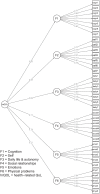German validation of Quality of Life after Brain Injury (QOLIBRI) assessment and associated factors
- PMID: 28542226
- PMCID: PMC5443488
- DOI: 10.1371/journal.pone.0176668
German validation of Quality of Life after Brain Injury (QOLIBRI) assessment and associated factors
Abstract
The consequences of traumatic brain injury (TBI) for health-related quality of life (HRQoL) are still poorly understood, and no TBI-specific instrument has hitherto been available. This paper describes in detail the psychometrics and validity of the German version of an internationally developed, self-rated HRQoL tool after TBI-the QOLIBRI (Quality of Life after Brain Injury). Factors associated with HRQoL, such as the impact of cognitive status and awareness, are specifically reported. One-hundred seventy-two participants after TBI were recruited from the records of acute clinics, most of whom having a Glasgow Coma Scale (GCS) 24-hour worst score and a Glasgow Outcome Scale (GOSE) score. Participants had severe (24%), moderate (11%) and mild (56%) injuries as assessed on the GCS, 3 months to 15 years post-injury. The QOLIBRI uses 37 items to measure "satisfaction" in the areas of "Cognition", "Self", "Daily Life and Autonomy", and "Social Relationships", and "feeling bothered" by "Emotions"and "Physical Problems". The scales meet standard psychometric criteria (α = .84 to .96; intra-class correlation-ICC = .72 to .91). ICCs (0.68 to 0.90) and αs (.83 to .96) were also good in a subgroup of participants with lower cognitive performance. The six-subscale structure of the international sample was reproduced for the German version using confirmatory factor analyses and Rasch analysis. Scale validity was supported by systematic relationships observed between the QOLIBRI and the GOSE, Patient Competency Rating Scale for Neurorehabilitation (PCRS-NR), Hospital Anxiety and Depression Scale (HADS), Profile of Mood States (POMS), Short Form 36 (SF-36), and Satisfaction with Life Scale (SWLS). The German QOLIBRI contains novel information not provided by other currently available measures and has good psychometric criteria. It is potentially useful for clinicians and researchers, in post-acute and rehabilitation studies, on a group and individual level.
Conflict of interest statement
Figures




Similar articles
-
Quality of Life after Brain Injury (QOLIBRI): scale development and metric properties.J Neurotrauma. 2010 Jul;27(7):1167-85. doi: 10.1089/neu.2009.1076. J Neurotrauma. 2010. PMID: 20486801
-
The Norwegian version of the QOLIBRI - a study of metric properties based on a 12 month follow-up of persons with traumatic brain injury.Health Qual Life Outcomes. 2017 Jan 19;15(1):14. doi: 10.1186/s12955-017-0589-9. Health Qual Life Outcomes. 2017. PMID: 28103876 Free PMC article.
-
Quality of Life after Brain Injury (QOLIBRI): scale validity and correlates of quality of life.J Neurotrauma. 2010 Jul;27(7):1157-65. doi: 10.1089/neu.2009.1077. J Neurotrauma. 2010. PMID: 20210602
-
Assessment of health-related quality of life in persons after traumatic brain injury--development of the Qolibri, a specific measure.Acta Neurochir Suppl. 2005;93:43-9. doi: 10.1007/3-211-27577-0_6. Acta Neurochir Suppl. 2005. PMID: 15986726 Review.
-
Quality of life in patients with traumatic brain injury-basic issues, assessment and recommendations.Restor Neurol Neurosci. 2002;20(3-4):111-24. Restor Neurol Neurosci. 2002. PMID: 12454360 Review.
Cited by
-
Comparison of Four Quality of Life Inventories for Patients with Traumatic Brain Injuries and Orthopedic Injuries.J Neurotrauma. 2020 Jun 15;37(12):1408-1417. doi: 10.1089/neu.2019.6746. Epub 2020 Mar 11. J Neurotrauma. 2020. PMID: 32000584 Free PMC article.
-
The psychometric validation of the Dutch version of the Rivermead Post-Concussion Symptoms Questionnaire (RPQ) after traumatic brain injury (TBI).PLoS One. 2019 Oct 24;14(10):e0210138. doi: 10.1371/journal.pone.0210138. eCollection 2019. PLoS One. 2019. PMID: 31647814 Free PMC article.
-
Quality of life up to 10 years after traumatic brain injury: a cross-sectional analysis.Health Qual Life Outcomes. 2020 Jun 4;18(1):166. doi: 10.1186/s12955-020-01391-3. Health Qual Life Outcomes. 2020. PMID: 32498679 Free PMC article.
-
The association of acute and chronic phase cerebrovascular reactivity with patient reported quality of life following moderate-to-severe traumatic brain injury.Sci Rep. 2024 Sep 5;14(1):20737. doi: 10.1038/s41598-024-71843-z. Sci Rep. 2024. PMID: 39237683 Free PMC article.
-
Longitudinal Internal Validity of the Quality of Life after Brain Injury: Response Shift and Responsiveness.J Clin Med. 2023 Apr 29;12(9):3197. doi: 10.3390/jcm12093197. J Clin Med. 2023. PMID: 37176640 Free PMC article.
References
-
- Corrigan JD, Bogner J. Latent factors in measures of rehabilitation outcomes after traumatic brain injury. J Head Trauma Rehabil. 2004;19: 445–458. - PubMed
Publication types
MeSH terms
Substances
LinkOut - more resources
Full Text Sources
Other Literature Sources

